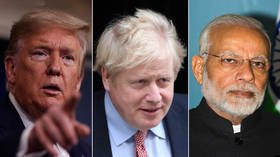As India locks itself down over coronavirus, West’s bias factory is working overtime

It was long, irritating, and refused to go away. A 30-second public service announcement started appearing on each of India’s 1.28 billion mobile phones in early March, warning about the coronavirus threat and how to prevent it.
This was one of the milder measures that the government of Narendra Modi has taken to stop the pandemic from spreading across India’s massive population, large chunks of which are still poor and depend on a medical system largely unequipped for a disaster of this scale.
But feeding on this massive challenge, the Western media has been relentless in its negativity despite not being able to disprove India’s relatively low number of cases and deaths.
The Washington Post headlines were unwaveringly critical: ‘As India goes into lockdown, fear spreads: ‘Poverty may kill us first’’ or ‘India marshals more resources to stop virus, but gaps remain’.
The New York Times chose to highlight the inevitable hardship of urban migration, without mentioning that direct cash transfers worth billions to the accounts of the poor have already taken place and more have been announced. ‘India’s coronavirus lockdown leaves vast numbers stranded and hungry,’ its headline said.
The Guardian didn’t have an answer as to what a nation of this size would do to prevent mass deaths if it didn’t put a lockdown into effect. ‘Overcome by anxiety: Indians in lockdown many can ill afford,’ it declared nonetheless.
What India did right
India started screening international travelers in mid-January. It banned the export of personal protective equipment like masks. In February, India stopped flights to mainland China and Hong Kong. In parallel, it started a nationwide public awareness campaigns.
Meanwhile, China and the World Health Organisation kept denying human-to-human spread of the disease almost till the end of January. US President Donald Trump kept up his bluster, stating time and again that coronavirus will never affect America. UK Prime Minister Boris Johnson flaunted how he kept shaking hands with everybody, making light of the pandemic, till the virus decided to visit him for a chat.
In all this, not for once did PM Narendra Modi utter a reckless word. He appeared on television twice – once on March 20 to call for a ‘Janta Curfew’ shutdown drill and to urge the nation to clap for those delivering essential services, and then on March 25, to announce a 21-day nationwide lockdown.
The government announced a package of 170 billion rupees (about $2.19 billion) for the poor, including farmers, migrant workers, disabled and women. A major part of that is direct cash transfers to bank accounts. There were also increased food rations, free gas cylinders, wage increases and higher loan limits.
The Reserve Bank of India came up with relief for the middle class, putting on hold loan instalment payments by three months.
The public distribution machinery has been activated to ensure essentials reach citizens despite the lockdown, and a special boost was been given to e-commerce and home delivery services.
India’s shortcomings and challenges
In spite of earnest efforts, India continues to have large gaps in its public health system. It has just seven hospital beds per 10,000 people, compared to 29 in the US and 34 in Italy.
The Indian Council for Medical Research (ICMR) had identified just 60 government laboratories for coronavirus testing, and now, 51 private labs have got clearance to test. That is woefully inadequate in a country of 1.3 billion people. Besides, there are not enough test kits to scan the population at South Korea’s level.
Among private players, only one has reportedly got the approval to undertake testing, while several applications are pending. Given the genome sequence of the disease has been out in the public domain since March 24, this is crucial time wasted.
There is also criticism that while declaring a lockdown, the government did not foresee a mass reverse migration of the urban poor back to their villages under the harshest, unsafe conditions.
Also on rt.com India’s migrant exodus: Media and liberals attempt to use national crisis to destabilize Modi government amid lockdownShould the West be snide?
In spite of such challenges, India has just over 2,000 cases so far and 58 deaths. China has officially admitted to 82,381 cases and 3,316 deaths till now, and Italy’s toll is 13,155 from 110,574 detected cases.
The relatively low numbers have not stopped Western experts from taking unprovoked potshots at India.
“Thank God this didn’t start in somewhere like India, because there’s absolutely no way that the quality of Indian governance could move to react in the way that the Chinese have done, that’s the good side of the Chinese model, and I think you could probably say the same about Brazil too,” Jim O’Neill, British-born former Goldman Sachs chief economist, said in early March.
In O’Neill’s Britain, there have been 29,865 cases and 2,357 deaths so far, with roughly one in 13 patients dying. India has 2,004 cases with 58 deaths, one in 35.
Meanwhile in Jim O'Neil's country pic.twitter.com/PrId2f1qSo
— the bazaar report🇮🇳 (@prydstar) March 21, 2020
“I still find it shocking that India, one of the world's largest, most densely packed populations, has been practically untouched by this outbreak. Explanations?” tweeted Trump supporter and TV host Bill Mitchell.
Because India has taken severe steps at the risk of its economy and public inconvenience, perhaps?
I still find it shocking that India, one of the world's largest, most densely packed populations, has been practically untouched by this outbreak.Explanations?
— Bill Mitchell (@mitchellvii) March 24, 2020
The West’s double standards never cease. So when people across India’s vast expanse clapped and blew conch shells in tribute to essential services workers on March 22, people like US economist Steve Hanke could not digest it.
.@narendramodi should've treated the #Coronavirus seriously earlier. Instead of preparing #India for a #Lockdown, he advised citizens to beat utensils to show solidarity for India’s poor, understaffed #Doctors. Action delivers. Rhetoric does not.https://t.co/I1kyEbtxAB
— Prof. Steve Hanke (@steve_hanke) March 25, 2020
Yet these experts never uttered a word when Britain did the same for its National Health Services heroes, or when Italy or Spain did it for their essential services officials.
The Atlantic Daily commissioned a piece on coronavirus in India, which much of it spent on an ideological rant about "Narendra Modi’s Hindu-nationalist government" that allegedly "openly discriminated against Muslims and undermined India’s secular foundations" and led to a "pogrom in which dozens of people—mostly Muslims—have been killed.”
Whether it is the Delhi riots, anti-Citizenship Amendment Act protests or the scrapping of special status for Kashmir, mainstream media in the West has shown unfailing bias and hypocrisy against India. So much so, that India has got used to it.
Right now, the nation has a much bigger worry on its mind: battling a lethal, invisible enemy, out to get the world’s second largest population.
Think your friends would be interested? Share this story!
The statements, views and opinions expressed in this column are solely those of the author and do not necessarily represent those of RT.














